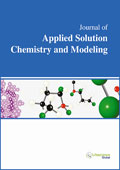jascm
Abstract : New Conditions of Saturation of Aqueous Solutions for the Modeling of Regions of Solid Phases
|
|
Abstract: In modeling the regions of precipitation and formation of thin films, we used four conditions: 1. The rule of solubility product; 2. The rule of molecular solubility; 3. The rule of solubility by intermediate; 4. Condition of precipitate of priority. This technique was used to build mathematical models of equilibriums from the pH of solution, concentration of reactants, and temperature. Mathematical models were also developed on the basis of experimental data obtained by potentiometry, residual concentration, thermogravimetry, etc. This model considers fluctuations of the pH of solution and predicts the chemical composition of compounds. It has been demonstrated that in synthesizing target compounds, the possibility of processes of fluctuations must be taken into account. A systemic mathematical model has been designed to optimize the synthesis of thin films and target compounds. Keywords: Mathematical modelling of equilibriums; conditions of saturation of aqueous solutions; the thin films of the lead sulfide.Download Full Article |
Abstract : A Thermodynamic Model on a Linear Rule between the Molal Concentration Exponential and the Osmotic Coefficients on Mole Fraction Base in Electrolyte Solutions and its Application
|
|
Abstract: A linear rule is discovered. That is the osmotic coefficients on mole fraction base (ω) are linearly related to the molal concentration exponential (mk2) in single electrolyte solutions. Based on this rule, a thermodynamic model is developed and successfully used to the single electrolytes with various valent types, such as uniunivalent, biunivalent, triunivalent, tetraunivalent,bibivalent, andtribivalent to predict their conventional osmotic coefficients on molal base (Φ), and also other properties, such as the relative molal vapor pressure lowering, the equivalent conductivity. Besides mk2, the xk2 (the concentration exponential of mole fraction of solute) mk2ln(mk2), and xk2ln(xk2) are also linearly related to ω, respectively. They are all capable to be used to reproduce some properties of single electrolyte solutions. The examples with satisfied results have been given. Keywords: Linear rule, single electrolyte solution, mixed electrolyte solution, osmotic coefficient, conductivity, solubility, Shannon information entropy.Download Full Article |
Abstract : A Thermodynamic Model on a Linear Rule between the Molal Concentration Exponential and the Osmotic Coefficients on Mole Fraction Base in Electrolyte Solutions and its Application (2)
|
|
Abstract: A linear rule is discovered. That is the osmotic coefficients on mole fraction base (ω) are linearly related to the molal concentration exponential (mk2) in single electrolyte solutions. Based on this rule, a thermodynamic model is developed and successfully used to the single electrolytes with various valent types, such as uniunivalent, biunivalent, triunivalent, tetraunivalent,bibivalent, andtribivalent to predict their conventional osmotic coefficients on molal base (Φ), and also other properties, such as the relative molal vapor pressure lowering, the equivalent conductivity. Besides mk2, the xk2 (the concentration exponential of mole fraction of solute) mk2ln(mk2), and xk2ln(xk2) are also linearly related to ω, respectively. They are all capable to be used to reproduce some properties of single electrolyte solutions. The examples with satisfied results have been given. Keywords: Linear rule, single electrolyte solution, mixed electrolyte solution, osmotic coefficient, conductivity, solubility, Shannon information entropy.Download Full Article |
Abstract : Structural Data, Linear and Nonlinear Optical Properties of Some Cyclic Phosphazenes: A Theoretical Investigation
|
|
Abstract: We report ab initio and DFT calculation of structural data, dipole moment, diagonal vibrational and electronic contributions to polarizability, vibrational and electronic contributions to first hyperpolarizability of some cyclic phosphazenes. The electronic structure of substituted cyclic phosphazenes has been investigated using Hartree-Fock and density functional theory. The vibrational and electronic contributions to polarizabilities and first hyperpolarizability of these molecules were calculated with HF method, and different DFT levels used the traditional B3LYP and PBE functional and the long-range corrected functional like Coulomb-attenuating method CAM-B3LYP, LC-BLYP and wB97XD used different basis sets. These cyclic phosphazenes adopts a planar structure. The study reveals that the cyclic phosphazenes derivatives have large vibrational contribution to static first hyperpolarizability values. The results obtained from this work will provide into the electronic properties of this important class of inorganic polymers. Keywords: Mean polarizability, polarizability anisotropy, vibrational and electronic polarizability, vibrational and electronic first hyperpolarizability. Download Full Article |






















